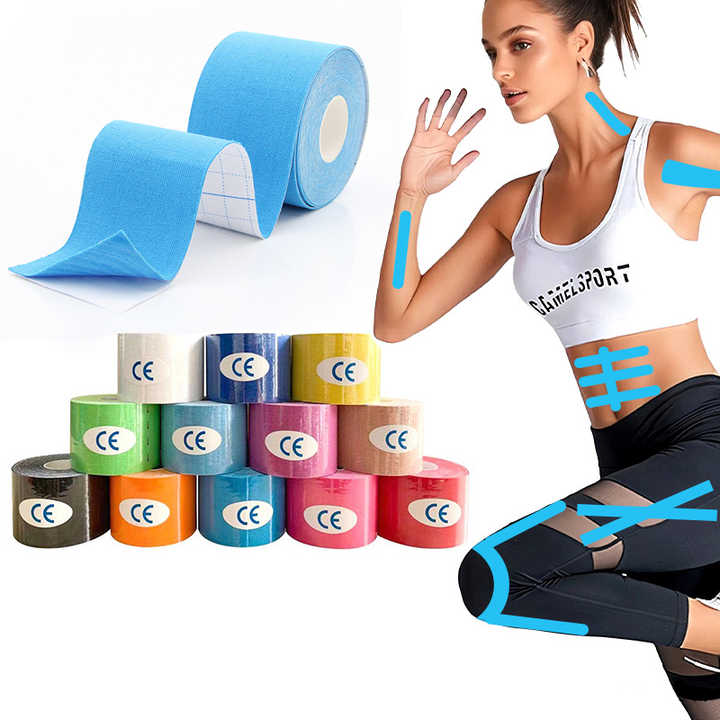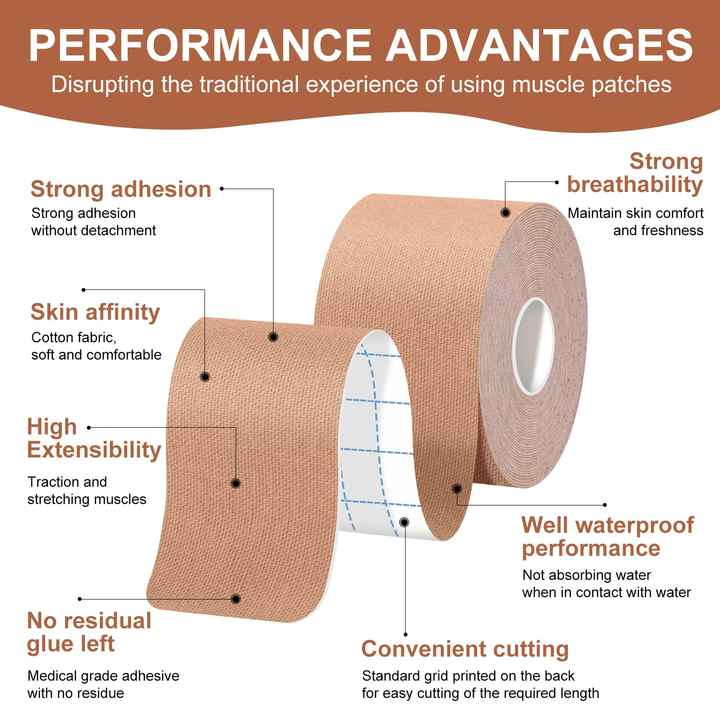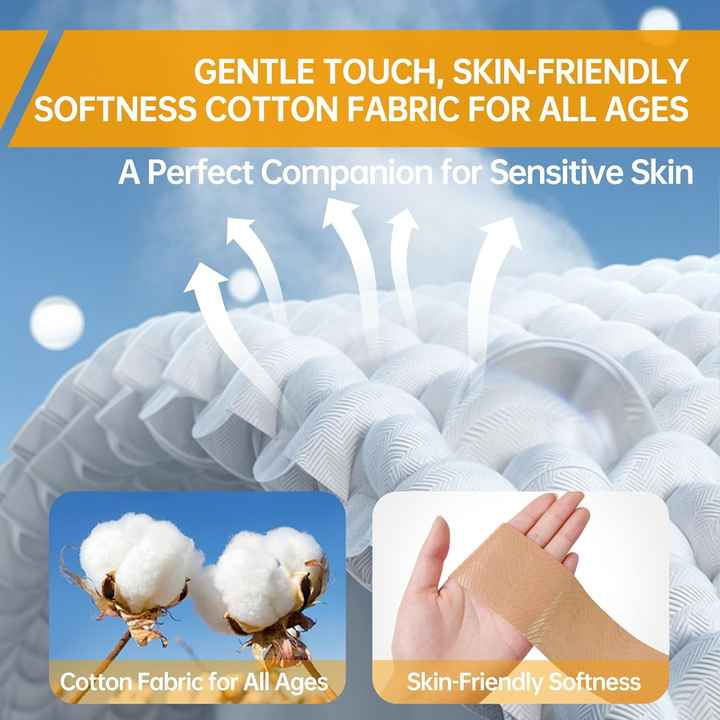What is Medical Adhesive Tape?
Medical adhesive tape, or surgical tape, is used to attach bandages, gauze, and other dressings to the skin around wounds.
Most adhesive tapes are pressure-sensitive tape; i.e., tape that sticks and stays in place with firm pressure. There’s no need for heat activation or a solvent. Medical adhesive tape can be made from various materials, but most are breathable for comfort and ease of use.
DIFFERENT USES FOR MEDICAL TAPE
Holding bandages and wound dressings
Supporting medical devices
Ostomy system care
Surgical drapes
and many more!
Main Types of Medical Adhesive Tape
In the medical field, different types of adhesive tape are used for different things. Some have softer components, such as cotton, while others are more elastic to support flexibility. Here are some of the most common types of medical adhesive tape and how they differ.
1. MEDICAL ADHESIVE TAPE FOR URGENT NEEDS
Micropore Paper Tape
Commonly used to secure bandages and dressings to the skin without leaving a sticky residue, micropore paper tape is hypoallergenic and can be used long-term without fear of skin irritation. Its adhesive sticks to the skin, underlying tape, or directly to dressing materials. Tiny holes, or micropores, in the tape make it breathable (speeding up healing) and easy to tear (ideal for emergencies).
Transpore Polyethylene Tape
This hypoallergenic, translucent tape sticks to the patient without sticking to surgical gloves or other surgical tools. It adheres well to wet surfaces — such as bleeding or sweating patients — so this powerful tape is often used to secure tubing or dressings. Transpore tape is breathable, although inflexible, and made from a non-stretch film.
Medical professionals on the go, including EMS and ambulance workers, regularly use transpore polyethylene tape because it’s efficient, durable, and sticks well to any surface, including those covered in hair, water, or blood. It’s also waterproof, allowing patients to keep it on in the shower or swimming.
Transpore tape’s breathable material allows adequate airflow for healing and allows sweat and other bodily fluids to pass through it. Because it’s one of the stronger varieties, it can leave residue on the skin or irritate those with sensitive skin.
2. MEDICAL ADHESIVE TAPE FOR EVERYDAY USE
Micropore paper tape can also function well in less high-pressure situations. It is gentle on the skin (leaving no sticky residue) and stays in place for several days without falling off, even though it’s not one of the strongest adhesive tapes.
Micropore tape is breathable— promoting wound healing— and easy to remove. Although it can withstand some moisture and sweat, it’s not waterproof, and it’s not as flexible or mailable as other adhesive tapes.
3. MEDICAL ADHESIVE TAPE FOR ATHLETICS
Zinc Oxide Tape
Commonly used to prevent sports injuries, zinc oxide tape also helps protect wounds, accelerating healing, stabilizing injuries, and protecting athletes from soft tissue damage.
Zinc oxide tape is a very durable material that works well in humid environments and tolerates high moisture levels (sweat). It’s typically made from either rayon or non-stretch cotton and remains intact for hours, allowing athletes to bend, twist, run, and push their physical limits.
When you’re searching for medical adhesive tape that’s strong, durable, and flexible, zinc oxide tape (sports tape) is the answer.
While regular adhesive tapes work best on flat areas of the body — forearm, shin, back — most athletic tapes are designed to conform to flexible, moving parts and stay put. Zinc oxide tape is strong enough to allow athletes to move easily without fear of losing the tape or injury.
Durable Cloth Tape
Cloth tape is one of the most versatile and widely used types of medical adhesive tape. It sticks best to the skin (not directly to a cloth dressing or bandage), doesn’t leave a sticky residue when removed, tears in any direction, and is ideal for long-term use thanks to its breathability. Durable cloth tapes are flexible, comfortable, and often used to secure splints.
4. WATERPROOF MEDICAL ADHESIVE TAPE
Although it’s specifically designed for use in water, waterproof adhesive tape only works when applied to dry skin or if the tape itself is dry to start with.
Most waterproof tape is exceptionally flexible and malleable. It conforms to the body and sticks to curved surfaces (between fingers and toes, on joints, etc.).
This adhesive tape is also incredibly flexible, easily conforming between fingers and toes, under the armpit, and on the palm as it flexes and moves with the body. Despite its strength, waterproof tape can be torn by hand, making it perfect for fast-paced situations.
Waterproof adhesive tape isn’t just for swimmers. One of its primary uses is protection against blisters and chafing skin. This tape sticks well to the skin but won’t adhere to hair, so skin surfaces must be prepared.
What is the difference between medical tape and normal tape?
Medical tapesare an essential part of healthcare settings, used for a variety of purposes such as securing dressings, immobilizing joints, and securing medical devices. However, with so many different types of medical tapes available, it can be overwhelming to determine which one is best suited for a specific application. Understanding the different types of medical tapes and their properties is crucial for healthcare professionals to make informed decisions and provide optimal patient care. In this article, we will explore the various types of medical tapes and their uses, helping you navigate the world of medical adhesives with confidence.
The importance of medical tapes in healthcare settings
Medical tapes play a vital role in healthcare settings, as they are used to secure dressings, immobilize joints, and secure medical devices. These tapes not only provide physical support but also prevent infection and promote wound healing. They create a barrier that protects the wound from bacteria, dirt, and moisture, reducing the risk of complications.
In addition, medical tapes contribute to patient comfort and satisfaction. They are designed to be gentle on the skin, minimizing the risk of skin irritation and allergies. Medical tapes also provide flexibility, allowing patients to move comfortably without compromising the effectiveness of the dressing or device.
With the right selection and application of medical tape, healthcare professionals can ensure optimal patient care, promote faster recovery, and enhance patient outcomes. It is essential to understand the different types of medical tapes available to choose the most appropriate option for each specific situation.
Different types of medical tapes and their uses
There are several different types of medical tapes available, each with its own unique properties and suitable uses. Understanding the characteristics of these tapes can help healthcare professionals make informed decisions when choosing the most appropriate option for their patients.
Paper tapes: Paper tapes are a common choice for securing dressings and medical devices. They are gentle on the skin and provide adequate adhesion without causing irritation or damage. These tapes are breathable, allowing moisture to evaporate and reducing the risk of maceration. Paper tapes are suitable for patients with sensitive or fragile skin.
Cloth tapes: Cloth tapes offer excellent adhesion, making them suitable for securing heavier dressings and devices. They are durable and provide extra support, making them ideal for immobilizing joints or securing splints. However, cloth tapes may not be as breathable as other options, which can increase the risk of moisture buildup and skin irritation.
Foam tapes: Foam tapes are highly absorbent and provide cushioning, making them suitable for wounds that require gentle pressure. They conform well to irregular surfaces and can be used to secure dressings in challenging areas. Foam tapes are also helpful in reducing pain associated with wound management.
Transparent tapes: Transparent tapes are ideal for situations where visibility is crucial. They allow healthcare professionals to monitor the wound or IV site without removing the tape. These tapes are also waterproof, protecting the wound from moisture and reducing the risk of infection.
Silicone tapes: Silicone tapes are gentle and hypoallergenic, making them suitable for patients with sensitive or compromised skin. They are pain-free to remove, reducing discomfort during tape changes. Silicone tapes are often used in delicate areas, such as pediatrics or geriatrics, where skin sensitivity is a concern.
By understanding the different types of medical tapes and their specific uses, healthcare professionals can make informed decisions that prioritize patient comfort, optimize wound care, and promote faster recovery. Careful consideration of factors such as adhesive strength, breathability, and compatibility with patient needs will ensure the most appropriate and effective choice of medical tape for each unique situation.




